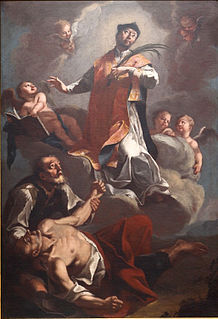Related Research Articles

Agnes of Rome is a virgin martyr, venerated as a saint in the Catholic Church, Oriental Orthodox Church and the Eastern Orthodox Church. St. Agnes is one of several virgin martyrs commemorated by name in the Canon of the Mass.

According to the gospels of Matthew and Luke in the New Testament, Mary was a first-century Jewish woman of Nazareth, the wife of Joseph, and the mother of Jesus. Both the New Testament and the Quran describe Mary as a virgin. According to Christian theology, Mary conceived Jesus through the Holy Spirit while still a virgin, and accompanied Joseph to Bethlehem, where Jesus was born.

Philomena, also known as Saint Philomena, was a young consecrated virgin whose remains were discovered on May 24–25, 1802, in the Catacomb of Priscilla. Three tiles enclosing the tomb bore an inscription, Pax Tecum Filumena, that was taken to indicate that her name was Filumena, the English form of which is Philomena. Philomena is the patron saint of infants, babies, and youth.

Saint Valentine was a 3rd-century Roman saint, commemorated in Western Christianity on February 14 and in Eastern Orthodoxy on July 6. From the High Middle Ages, his Saints' Day has been associated with a tradition of courtly love. He is also a patron saint of Terni, asthma and beekeepers. Saint Valentine was a clergyman – either a priest or a bishop – in the Roman Empire who ministered to persecuted Christians. He was martyred and his body buried at a Christian cemetery on the Via Flaminia on February 14, which has been observed as the Feast of Saint Valentine since at least the eighth century.

Valentine's Day, also called Saint Valentine's Day or the Feast of Saint Valentine, is celebrated annually on February 14. It originated as a Christian feast day honoring one or two early Christian martyrs named Saint Valentine and, through later folk traditions, has become a significant cultural, religious, and commercial celebration of romance and love in many regions of the world.

Margaret, known as Margaret of Antioch in the West, and as Saint Marina the Great Martyr in the East, is celebrated as a saint on 20 July in the Western Rite Orthodoxy, Roman Catholic Church and Anglicanism, on 17 July by the Eastern Orthodox Church and on Epip 23 and Hathor 23 in the Coptic Orthodox Church of Alexandria.

Saint Ursula is a legendary Romano-British Christian saint who died on 21 October 383. Her feast day in the pre-1970 General Roman Calendar is 21 October. There is little information about her and the anonymous group of holy virgins who accompanied and, on an uncertain date, were killed along with her at Cologne. They remain in the Roman Martyrology, although their commemoration does not appear in the simplified Calendarium Romanum Generale of the 1970 Missale Romanum.

April 13 - Eastern Orthodox liturgical calendar - April 15
Saints Theodora and Didymus are Christian saints whose legend is based on a 4th-century acta and the word of Saint Ambrose. The pair were martyred in the reigns of co-ruling Roman Emperors Diocletian and Maximianus. St. Theodora should not be confused with another St. Theodora of Alexandria commemorated on September 11.

February 28 - Eastern Orthodox liturgical calendar - March 2
The General Roman Calendar is the liturgical calendar that indicates the dates of celebrations of saints and mysteries of the Lord in the Roman Rite of the Catholic Church, wherever this liturgical rite is in use. These celebrations are a fixed annual date; or occur on a particular day of the week ; or relate to the date of Easter. National and diocesan calendars, including that of the diocese of Rome itself as well as the calendars of religious institutes and even of continents, add other saints and mysteries or transfer the celebration of a particular saint or mystery from the date assigned in the General Calendar to another date.

The Diocese of Terni-Narni-Amelia is a Latin Church ecclesiastical territory or diocese of the Catholic Church in Umbria, central Italy. It was created in 1983, when the Diocese of Amelia was united with the Diocese of Terni and Narni. The latter had been in turn created in 1907, when the Diocese of Narni was united to the historical Diocese of Terni. The diocese is immediately exempt to the Holy See, not part of any ecclesiastical province.
Domnina can refer to:

The title Virgin is an honorific bestowed on female saints and blesseds in both the Eastern Orthodox Church and the Roman Catholic Church.

Saint Domnina of Syria, also known as Domnina the Younger, was a 5th-century ascetic. Her name is mentioned in the Byzantine Synaxarium. and according to Theodoret, bishop of Cyrrhus, Domnina was born to a rich Syrian family.

Saint Domnina is venerated as a Christian martyr by the Roman Catholic and Eastern Orthodox Churches. According to tradition, she was a native of Cilicia who was imprisoned at Anazarbus and repeatedly beaten on the order of the Roman prefect Lysias. She was then burned with fire. She died in prison.
Saint Domnina and her daughters Berenice and Prosdoce are venerated as Christian martyrs by the Roman Catholic and Eastern Orthodox Churches.

October 11 – Eastern Orthodox liturgical calendar – October 13
The Catacombs of San Valentino is one of the catacombs of Rome (Italy), placed at the 2nd mile of the via Flaminia, now in Viale Maresciallo Pilsudski, in the modern Pinciano neighborhood.

Perpetua and Felicity were Christian martyrs of the 3rd century. Vibia Perpetua was a recently married well educated noblewoman, said to have been 22 years old at the time of her death, and mother of an infant she was nursing. Felicity, an enslaved woman imprisoned with her and pregnant at the time, was martyred with her. They were put to death along with others at Carthage in the area of Africa in the Roman province of Africa.
References
- 1 2 "St. Domnina". Catholic Online. n.d. Retrieved May 19, 2009.
- ↑ "Narni and Terni". Catholic Encyclopedia. 1913. Retrieved May 19, 2009.
- 1 2 Benedictine Monks, Book of the Saints (Published by Kessinger Publishing, 2003), 83-84.